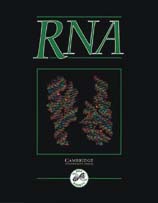Crossref Citations
This article has been cited by the following publications. This list is generated based on data provided by
Crossref.
Proctor, David J.
Schaak, Janell E.
Bevilacqua, Joanne M.
Falzone, Christopher J.
and
Bevilacqua, Philip C.
2002.
Isolation and Characterization of a Family of Stable RNA Tetraloops with the Motif YNMG That Participate in Tertiary Interactions.
Biochemistry,
Vol. 41,
Issue. 40,
p.
12062.
Decatur, Wayne A
and
Fournier, Maurille J
2002.
rRNA modifications and ribosome function.
Trends in Biochemical Sciences,
Vol. 27,
Issue. 7,
p.
344.
Müller, Ulrich F.
and
Bartel, David P.
2003.
Substrate 2′-Hydroxyl Groups Required for Ribozyme-Catalyzed Polymerization.
Chemistry & Biology,
Vol. 10,
Issue. 9,
p.
799.
Höbartner, Claudia
and
Micura, Ronald
2003.
Bistable Secondary Structures of Small RNAs and Their Structural Probing by Comparative Imino Proton NMR Spectroscopy.
Journal of Molecular Biology,
Vol. 325,
Issue. 3,
p.
421.
Sarzynska, Joanna
Nilsson, Lennart
and
Kulinski, Tadeusz
2003.
Effects of Base Substitutions in an RNA Hairpin from Molecular Dynamics and Free Energy Simulations.
Biophysical Journal,
Vol. 85,
Issue. 6,
p.
3445.
Proctor, David J.
Ma, Hairong
Kierzek, Elzbieta
Kierzek, Ryszard
Gruebele, Martin
and
Bevilacqua, Philip C.
2004.
Folding Thermodynamics and Kinetics of YNMG RNA Hairpins: Specific Incorporation of 8-Bromoguanosine Leads to Stabilization by Enhancement of the Folding Rate.
Biochemistry,
Vol. 43,
Issue. 44,
p.
14004.
Gherghe, Costin M.
Krahn, Joseph M.
and
Weeks, Kevin M.
2005.
Crystal Structures, Reactivity and Inferred Acylation Transition States for 2‘-Amine Substituted RNA.
Journal of the American Chemical Society,
Vol. 127,
Issue. 39,
p.
13622.
Hennig, Mirko
Fohrer, Jörg
and
Carlomagno, Teresa
2005.
Assignment and NOE Analysis of 2‘-Hydroxyl Protons in RNA: Implications for Stabilization of RNA A-Form Duplexes.
Journal of the American Chemical Society,
Vol. 127,
Issue. 7,
p.
2028.
Fohrer, Jörg
Hennig, Mirko
and
Carlomagno, Teresa
2006.
Influence of the 2′-Hydroxyl Group Conformation on the Stability of A-form Helices in RNA.
Journal of Molecular Biology,
Vol. 356,
Issue. 2,
p.
280.
Baxter-Roshek, Jennifer L.
Petrov, Alexey N.
Dinman, Jonathan D.
and
Preiss, Thomas
2007.
Optimization of Ribosome Structure and Function by rRNA Base Modification.
PLoS ONE,
Vol. 2,
Issue. 1,
p.
e174.
Julien, Kristine R.
Sumita, Minako
Chen, Po-Han
Laird-Offringa, Ite A.
and
Hoogstraten, Charles G.
2008.
Conformationally restricted nucleotides as a probe of structure–function relationships in RNA.
RNA,
Vol. 14,
Issue. 8,
p.
1632.
Rinnenthal, Jörg
Richter, Christian
Nozinovic, Senada
Fürtig, Boris
Lopez, Jakob J.
Glaubitz, Clemens
and
Schwalbe, Harald
2009.
RNA phosphodiester backbone dynamics of a perdeuterated cUUCGg tetraloop RNA from phosphorus-31 NMR relaxation analysis.
Journal of Biomolecular NMR,
Vol. 45,
Issue. 1-2,
p.
143.
Blose, Joshua M.
Proctor, David J.
Veeraraghavan, Narayanan
Misra, Vinod K.
and
Bevilacqua, Philip C.
2009.
Contribution of the Closing Base Pair to Exceptional Stability in RNA Tetraloops: Roles for Molecular Mimicry and Electrostatic Factors.
Journal of the American Chemical Society,
Vol. 131,
Issue. 24,
p.
8474.
Banáš, Pavel
Hollas, Daniel
Zgarbová, Marie
Jurečka, Petr
Orozco, Modesto
Cheatham, Thomas E.
Šponer, Jiří
and
Otyepka, Michal
2010.
Performance of Molecular Mechanics Force Fields for RNA Simulations: Stability of UUCG and GNRA Hairpins.
Journal of Chemical Theory and Computation,
Vol. 6,
Issue. 12,
p.
3836.
Paladino, Antonella
and
Zangi, Ronen
2013.
Propensities for loop structures of RNA & DNA backbones.
Biophysical Chemistry,
Vol. 180-181,
Issue. ,
p.
110.
Lapinaite, Audrone
Simon, Bernd
Skjaerven, Lars
Rakwalska-Bange, Magdalena
Gabel, Frank
and
Carlomagno, Teresa
2013.
The structure of the box C/D enzyme reveals regulation of RNA methylation.
Nature,
Vol. 502,
Issue. 7472,
p.
519.
Paladino, Antonella
and
Zangi, Ronen
2013.
Ribose 2′-Hydroxyl Groups Stabilize RNA Hairpin Structures Containing GCUAA Pentaloop.
Journal of Chemical Theory and Computation,
Vol. 9,
Issue. 2,
p.
1214.
Parlea, Lorena G.
Sweeney, Blake A.
Hosseini-Asanjan, Maryam
Zirbel, Craig L.
and
Leontis, Neocles B.
2016.
The RNA 3D Motif Atlas: Computational methods for extraction, organization and evaluation of RNA motifs.
Methods,
Vol. 103,
Issue. ,
p.
99.
Borkar, Aditi N.
Vallurupalli, Pramodh
Camilloni, Carlo
Kay, Lewis E.
and
Vendruscolo, Michele
2017.
Simultaneous NMR characterisation of multiple minima in the free energy landscape of an RNA UUCG tetraloop.
Physical Chemistry Chemical Physics,
Vol. 19,
Issue. 4,
p.
2797.
Whittum, Michelle E.
and
Blose, Joshua M.
2017.
Effects of osmolytes on stable UUCG tetraloops and their preference for a CG closing base pair.
Nucleosides, Nucleotides and Nucleic Acids,
p.
1.

